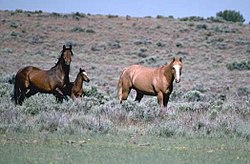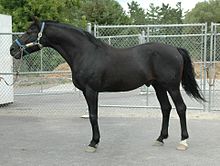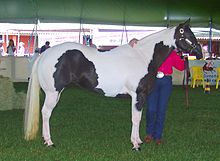HORSE BREEDS (part 1)
 Each horse breed has some special qualities and characteristic colors. So, for example, horses of the Budyonnovsky breed are usually red and never black. If a foal is born of an unusual suit for a given breed, then an impurity of some other breed is manifested.
Each horse breed has some special qualities and characteristic colors. So, for example, horses of the Budyonnovsky breed are usually red and never black. If a foal is born of an unusual suit for a given breed, then an impurity of some other breed is manifested.
The geographic distribution of the rocks was initially determined mainly by habitat conditions. In countries with severe winters, horses usually grow thick winter coat, and for wintering they had enough limited food supplies. And horses from countries with warmer climates are adapted to high temperatures. Human intervention has partly changed this situation. Some breeds became extinct, new ones were bred. The man also made a significant contribution to interbreeding.
To breed different breeds, special conditions for keeping horses are created. This is how horse factories came about with stables protecting horses from the scorching heat or winter cold; arenas with special soil for training horses; with fenced areas for grazing and watering. The horses harvest hay, straw and grain and they do not have to get their own feed in the winter from under the snow. Experienced grooms look after horses, veterinarians and trainers who train animals in accordance with their purpose closely monitor the growth and development.
In the world there are 200 (according to some sources 300) horse breeds. There is no single classification of horse breeds. In the USSR, a classification was developed, developed by the All-Union Research Institute of Horse Breeding, combining horse breeds in 3 main groups.
The 1st group includes factory breeds of horses bred under conditions created by man and having high working capacity.
These breeds are distinguished by the greatest specialization in working productivity and are divided according to this criterion into 4 types:
Heavy-duty (Russian, Vladimir, Soviet heavy trucks, arden, perchers, adhesive steel, suffolk, shire, Belgian heavy truck);
Draft (American standardbrednaya, Russian and Oryol trotters, Tori, Finnish and others);
Horse-harness (Hungarian, Greater Poland, German “half-blood”, Morgan and others).
Horseback (thoroughbred horseback, Budennovskaya, Trakenenskaya, gunther, Terskaya, Andalusian and others).
The 2nd group includes factory breeds of horses bred under conditions close to natural and having high working capacity.
They are relatively uniform in working productivity (horseback, horse-drawn), but they significantly differ in biological qualities, and therefore are divided into zonal groups:
Steppe (Don, Kustanai, Canadian and others);
Mountain (rocks of the Caucasus, Central Asia and others);
Southern Deserts (Akhal-Teke, Arab, Karabair, Yomud, Shiraz, Barbary and others).
The 3rd group includes local breeds formed under the influence of natural and artificial selection under conditions close to natural.
These breeds are not specialized in productivity (mainly working and working-meat-dairy), but differ in adaptability to local conditions and are classified taking into account distribution zones:
Northern forest (Vyatka, Pechora, Mezenskaya, Polesskaya, Oblast, Yakut and others);
Steppe (Mongolian, Transbaikal, Kazakh, Bashkir and others);
Mountain (Lokai, Kyrgyz, Altai, Tuvinian, Azerbaijani, Tushino, Megrelian, Hutsul and others).
Since the middle of the 20th century, in connection with the mechanization and automation of agriculture, which drove the horse out of its traditional use, in most countries with significant horse stocks, horses are mainly bred for equestrian sports (trotting, riding), and tourism (riding, pack, draft) ) and receiving products (meat and dairy). Most of these breeds are the result of centuries-old breeding, but there are also semi-wild breeds living in natural conditions.
The following groups of breeds are distinguished: Arabs, thoroughbreds, half-breeds, trotters, heavy and ponies.
Each breed differs from others in certain characteristics. For example, the English thoroughbred ridings are famous for their speed qualities, the Dutch draft horses for their strength, the Arabs for their grace and beauty, and the Hanoverians are used as sports horses.
There are only three purebred breeds: Arabian, Thoroughbred horse (English) and Akhalteke.



